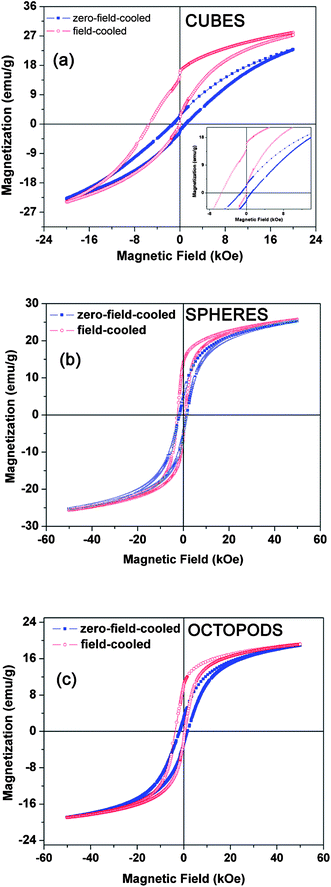1) Exchange bias effect in Au-Fe3O4 nanocomposites.
Sayan Chandra, N A Frey Huls, M H Phan, S Srinath, M A Garcia, Youngmin Lee, Chao Wang, Shouheng Sun, Òscar Iglesias and H Srikanth
Nanotechnology 25, 055702 (2014)
 |
| Low temperature hysteresis loops simulated after a cooling in a magnetic field hFC = 100 K
as computed by MC simulations of individual nanoparticles with cluster
(a) and dimer (b) geometries. The non-magnetic metal is simulated as a
hole in the middle for the cluster geometry and a sharp facet for the
cluster. Panels (a) and (b) show hysteresis loops of a particle with
cluster and dimer geometry, respectively, for two different values of
the surface anisotropy constant: kS = 0.01 (blue squares) equal to the core value kC = 0.01, and increased surface anisotropy kS = 30
(red circles). The dashed lines in (b) stand for a spherical particle
of the same size as the dimer. The inset displays the contribution of
the surface (yellow circles) and core (green squares) spins of a dimer
particle to the hysteresis loop for ks = 30. Snapshots of the spin configurations for cluster ((c) and (d) panels) and dimer ((e) and (f) panels) particles for kS = 30
obtained at the end of the FC process ((c) and (e) panels) and at the
coercive field point of the decreasing field branch ((d) and (f) panels)
of the hysteresis loops displayed in figures (a) and (b). For clarity,
only a slice of width 4a along the applied field direction and
through the central plane of the particles is shown. Surface spins have
darker colors and core spins have been colored lighter. |
2) Chemically synthesized Au–Fe3O4 nanostructures with controlled optical and magnetic properties.
Victor Velasco, Laura Muñoz, Eva Mazarío, Nieves Menéndez, Pilar Herrasti, Antonio Hernando and Patricia Crespo
J. Phys. D: Appl. Phys. 48, 035502 (2015)
 |
| (a) ZFC-FC magnetization curves of Fe3O4 and Au–Fe3O4 NPs measured under an applied field of 25 Oe. (b) Hysteresis loops of Fe3O4 and Au–Fe3O4
NPs with Au : Fe initial molar ratios of 1 : 1 and 1 : 3 measured at
5 K applying a maximum field of 50.000 Oe. The ferromagnetic behaviour
is highlighted in the inset. |
3) Spin Dynamics in Hybrid Iron Oxide-Gold Nanostructures.
Tomas Orlando,A. Capozzi, E. Umut, L. Bordonali, M. Mariani, P. Galinetto, F. Pineider, C. Innocenti, P. Masala, F. Tabak, M. Scavini, P. Santini, M. Corti, C . Sangregorio, P. Ghigna, and A. Lascialfari
 |
| We report a broadband 1H NMR study of the spin dynamics of
coated maghemite and gold–maghemite hybrid nanostructures with two
different geometries, namely dimers and core–shells. All the samples
have a superparamagnetic behavior, displaying a blocking temperature (TB
∼ 80 K (maghemite), ∼105 K (dimer), ∼150 K (core–shell)), and the
magnetization reversal time follows the Vogel–Fulcher law. We observed
three different anomalies in 1H NMR T1–1 versus T
that decrease in amplitude when increasing the applied magnetic field.
We suggest that the anomalies are related to three distinct system
dynamics: molecular rotations of the organic groups (240 < T < 270 K), superparamagnetic spin blockage (100 < T < 150 K), and surface–core spin dynamics (T < 25 K). By fitting the T1–1
data with a heuristic model, we achieved a good agreement with magnetic
relaxation data and literature values for methyl group rotation
frequencies. |
4) Superparamagnetic Au-Fe3O4 nanoparticles: one-pot synthesis, biofunctionalization and toxicity evaluation.
A Pariti, P Desai, S K Y Maddirala, N Ercal, K V Katti, X Liang and M Nath
Materials Research Express 1, 035023 (2014)
5) Spin-Polarization Transfer in Colloidal Magnetic-Plasmonic Au/Iron Oxide Hetero-nanocrystals.
Francesco Pineider, César de Julián Fernández, Valeria Videtta, Elvio Carlino, Awni al Hourani,Fabrice Wilhelm, Andrei Rogalev, P. Davide Cozzoli, Paolo Ghigna, and Claudio Sangregorio
ACS Nano 7, 857 (2013)
 |
| We report on the unprecedented direct observation of spin-polarization
transfer across colloidal magneto-plasmonic Au@Fe-oxide core@shell
nanocrystal heterostructures. A magnetic moment is induced into the Au
domain when the magnetic shell contains a reduced Fe-oxide phase in
direct contact with the noble metal. An increased hole density in the Au
states suggested occurrence of a charge-transfer process concomitant to
the magnetization transfer. The angular to spin magnetic moment ratio, morb/mspin,
for the Au 5d states, which was found to be equal to 0.38, appeared to
be unusually large when compared to previous findings. A mechanism
relying on direct hybridization between the Au and Fe states at the
core/shell interface is proposed to account for the observed transfer of
the magnetic moment. |

































